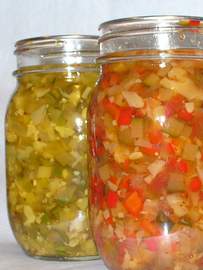 Canning relish recipes are a great way to preserve a variety of vegetables at the end of the season. From one basic relish recipe, you can create two different relishes, one red and spicy, the other green and zesty.
Canning relish recipes are a great way to preserve a variety of vegetables at the end of the season. From one basic relish recipe, you can create two different relishes, one red and spicy, the other green and zesty.
- Tip: Before you harvest or buy the fresh produce for any canning project, check that you have all of the required canning equipment in working condition, and basic supplies such as pickling salt, vinegar, sugar, and spices.
Relish has many delicious uses. Besides a topping for burgers or hot dogs, you can combine relish with yogurt to use as a dip for crackers or vegetables, blend it with vinegar and oil for a flavorful salad dressing, add it to mayonnaise and use as a sandwich spread, serve it with grilled or roasted meats and seafood, or perk up vegetarian meal of grains and legumes. This spicy red tomato and pepper relish pairs well with burgers and other red meats. The green pickle relish adds zest to potato, egg, and tuna salad, and makes a quick tartar sauce when stirred into mayonnaise, along with fresh herbs like parsley or chives.
Canned Red or Green Relish
Makes 7 pints
| Ingredients for Spicy Red | Ingredients for Zesty Green |
| 21 cups chopped vegetables: | 21 cups chopped vegetables: |
|
|
|
|
|
|
|
|
|
|
|
|
| 1⁄2 cup canning or pickling salt | 1⁄2 cup canning or pickling salt |
| 7 cups cider vinegar (5%) | 7 cups white vinegar (5%) |
| 3 1⁄2 cups brown sugar | 3 1⁄2 cups white sugar |
| 2 cloves garlic, minced | 2 cloves garlic, minced |
| 1 tablespoon celery seeds | 1 tablespoon celery seeds |
| 1 tablespoon mustard seeds | 1 tablespoon mustard seeds |
| 1⁄2 teaspoon ground allspice | 1 teaspoon mustard powder |
| 1⁄2 teaspoon ground cinnamon | 1⁄2 teaspoon turmeric |
| 1⁄2 teaspoon ground cloves | 1⁄2 teaspoon cayenne pepper |
Directions:
- Begin the day before. In a large bowl, toss together chopped vegetables and canning salt. Cover and refrigerate 12 to 18 hours. Drain vegetables thoroughly in a colander.
- In a large stockpot, stir together vinegar, sugar, garlic, and seasonings. Bring to a boil over high heat. Reduce heat to medium-low and simmer, covered for 10 minutes. Add vegetables, raise heat again to high, return to a boil, and simmer, partially covered for an additional 30 minutes. Keep mixture hot while filling jars.
- While the relish is cooking, prepare a boiling water–bath (BWB) canner, pint jars, and lids.
- Fill hot jars by the hot-pack method, lading hot product into hot jars, and adjusting headspace to 1/2-inch. Clean the rim and secure the lid.
- Process pint jars in a BWB canner for 15 minutes. Properly cool and store the jars. Use within one year for best flavor.
Unbreakable rules for safely canning acidified foods
It is best to follow tested recipes exactly when canning foods. People have the most trouble with canning when they don’t understand essential concepts, why a step is necessary, or take shortcuts that make the food unsafe. However, if you are trying to efficiently use up produce from your garden or the farmers market, you may have slightly different amounts on hand. Or perhaps you like tangy foods or sweet-hot foods and want to make adjustments in flavor. It can be done, if you know the rules and follow them. So here they are:
- Never alter the proportions of solids and liquids (vinegar, water, or other liquids) in a canning recipe for acidified foods such as relish or pickles.
- When canning foods with vinegar added, the only safe adjustments are to sugar, salt, and seasonings, which you may freely omit, add, increase, or decrease.
- You may substitute one type of vegetable for another in equal amount (but do not alter proportions of solids and liquids).
- You may substitute one type of vinegar for another, as long as it is equal or greater strength. For example, you may substitute 5% vinegar with 5%, 6%, or 7% vinegar, but not 4% vinegar. Check the label carefully.
- You can increase the sugar if you prefer sweeter relish,
- You can increase the cayenne pepper if you want a hotter relish.
- You can eliminate, change, or add spices to alter the flavors, such as more cinnamon, less mustard, or by adding cumin seed.
This relish recipe demonstrates how one canning recipe can be made safely to create two very different relish products by substituting one vegetable for another (in equal amounts) and changing the type (but not amount) of vinegar, as well as the changing the type of sugar and spices.
For information about canning and seven other food preservation methods, including over 300 delicious recipes, get the book The Home Preserving Bible by Carole Cancler.




